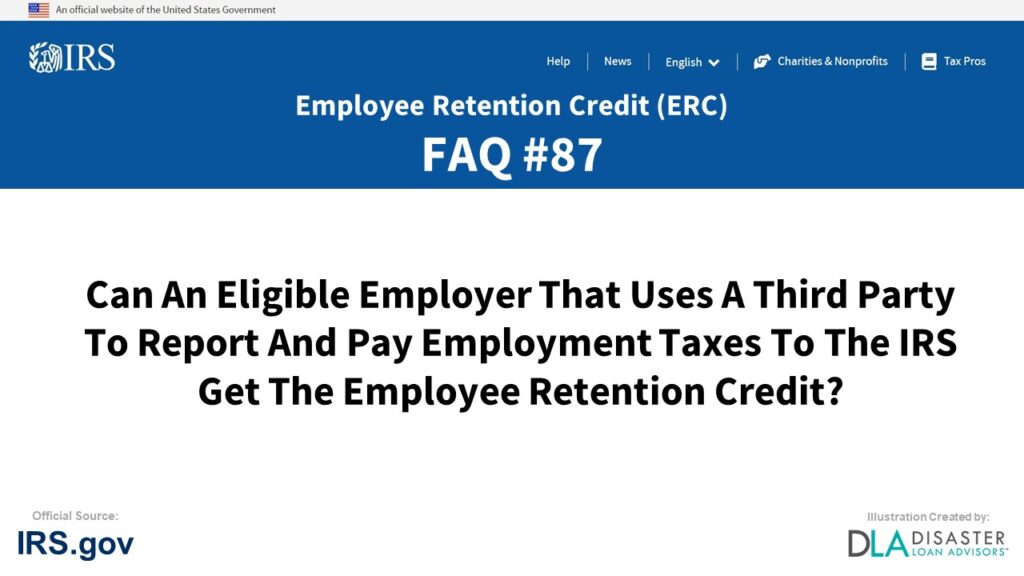
Frequently asked question #87 “Can an Eligible Employer that uses a third party to report and pay employment taxes to the IRS get the Employee Retention Credit?” under the Special Issues for Employers: Use of Third Party Payers section of FAQs: Employee Retention Credit under the CARES Act, provided by the IRS.gov to help business owners understand the ERC program. Information is below for the question #87 Can an Eligible Employer that uses a third party to report and pay employment taxes to the IRS get the Employee Retention Credit?
ERC Credit Frequently Asked Question #87:
COVID-19-Related Employee Retention Credits:
Special Issues for Employers FAQs
87. Can an Eligible Employer that uses a third party to report and pay employment taxes to the IRS get the Employee Retention Credit?
Yes, if a common law employer is otherwise eligible to receive the Employee Retention Credit, it is entitled to the credit, regardless of whether it uses a third party payer (such as a reporting agent, payroll service provider, PEO, CPEO, or agent) to report and pay its federal employment taxes.
The third party payer is not entitled to the Employee Retention Credit with respect to the wages it remits on the employer’s behalf (regardless of whether the third party is considered an “employer” for other purposes of the Internal Revenue Code (the “Code”)).
If an employer uses a third party to file, report, and pay employment taxes, certain rules for claiming/reporting the Employee Retention Credit will apply depending on the type of third party payer the employer uses.
If an Eligible Employer uses a reporting agent to file the Form 941, Employer’s Quarterly Federal Tax Return, the reporting agent will need to reflect the Employee Retention Credit on the Form 941 it files on the employer’s behalf.
If an Eligible Employer uses a CPEO or a 3504 agent to report its federal employment taxes on an aggregate Form 941, the CPEO or 3504 agent will report the Employee Retention Credit on its aggregate Form 941 and Schedule R, Allocation Schedule for Aggregate Form 941 Filers, that it already files.
An Eligible Employer can submit its own Form 7200, Advance Payment of Employer Credits Due to COVID-19, to claim the advance credit. The Eligible Employer will need to provide a copy of the Form 7200 to the CPEO or 3504 agent so the CPEO or 3504 agent can properly report the Employee Retention Credit on the Form 941.
If an Eligible Employer uses a non-certified PEO to report and pay its federal employment taxes, the PEO will need to report the Employee Retention Credit on an aggregate Form 941 and separately report the Employee Retention Credit allocable to the employers for which it is filing the aggregate Form 941 on an accompanying schedule R.
The PEO does not have to complete Schedule R with respect to employers for which it is not claiming an Employee Retention Credit. The Eligible Employer will need to provide a copy of any Form 7200 that it submitted for an advance to the PEO so the PEO can properly report the Employee Retention Credit on the Form 941.
These rules are similar to the rules that apply with respect to the payroll tax election available under section 41(h) of the Code for the credit for certain research and development expenses.
For more Internal Revenue Service (IRS) Department of the Treasury Employee Retention Credit (ERC) Special Issues for Employers: Use of Third Party Payers FAQs, visit the official IRS.gov tax website.
Conclusion and Summary on ERC Credit FAQ #87. Can an Eligible Employer that uses a third party to report and pay employment taxes to the IRS get the Employee Retention Credit?
The “Can an Eligible Employer that uses a third party to report and pay employment taxes to the IRS get the Employee Retention Credit?” is Frequently Asked Question #87 of many commonly asked questions small business owners are wondering about how to file the Employee Retention Tax Credit (ERTC). The IRS ERC Tax Credit program is a confusing and complex process to determine the correct ERC calculations your business qualifies for. Answers to “Can an Eligible Employer that uses a third party to report and pay employment taxes to the IRS get the Employee Retention Credit?” and filling out form 941-X may change slightly from frequently updated rules and regulations from the IRS. Leave a comment below if you have further questions on ERC Credit FAQ #87.
Help Completing / Filing / Claiming the Employee Retention Credit (ERC)
Receive Up to a $26,000 ERC Credit from the IRS Per Employee
Disaster Loan Advisors can assist your business with the complex and confusing Employee Retention Credit (ERC), Form 941-X, and the Employee Retention Tax Credit (ERTC) program.
Depending on eligibility, business owners and companies can receive up to $26,000 per employee based on the number of W2 employees you had on the payroll in 2020 and 2021.
The ERC / ERTC Tax Credit Program is a valuable IRS tax credit you can claim. This is money you have already paid to the IRS in payroll taxes for your W2 employees.
We DO NOT charge a percentage (%) of your ERC Refund like some companies are charging. Some ERC firms out there are charging upwards of 15% to 35% of your ERC refund!
Our professional ERC fee and pricing structure is very reasonable in comparison.
If you are looking for an ERC Company that believes in providing professional ERC Services and value, in exchange for a fair, reasonable, and ethical fee for the amount of work required, Disaster Loan Advisors is a good fit for you.
Schedule Your Free Employee Retention Credit Consultation to see what amount of employee retention tax credit your company qualifies for.
Cover Image Credit: Irs.gov / ERC FAQ / Disaster Loan Advisors.
